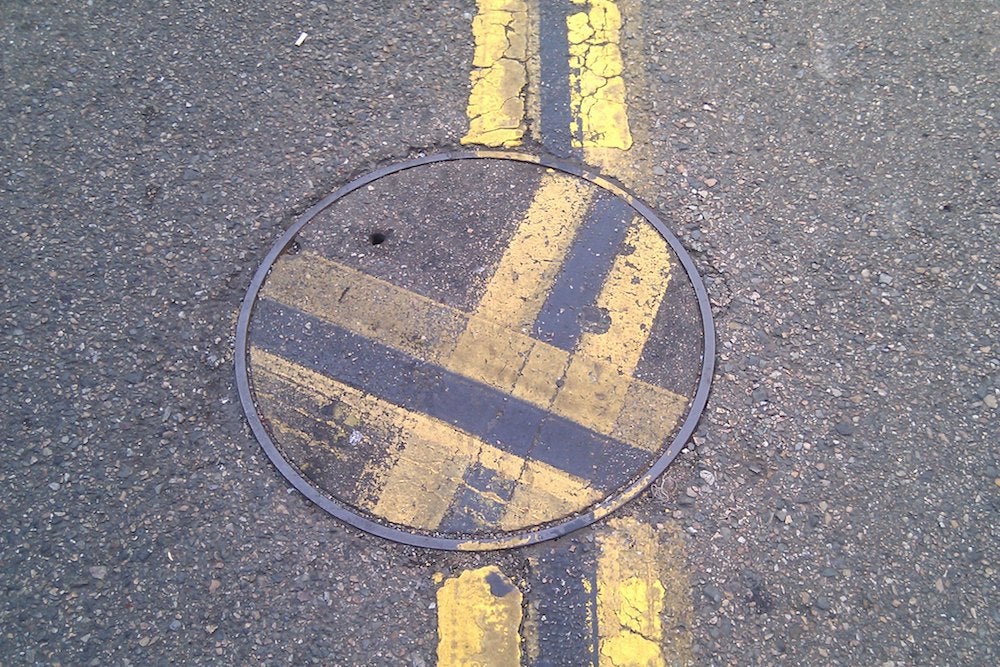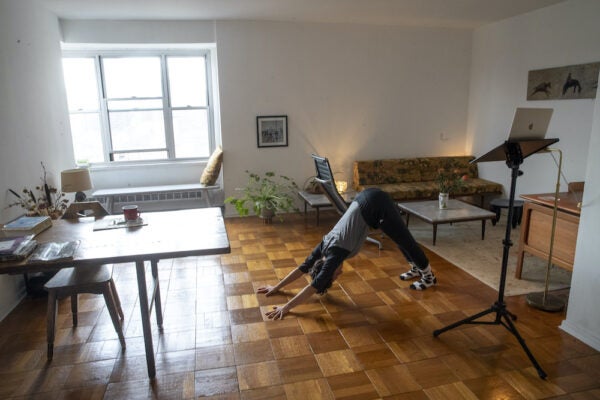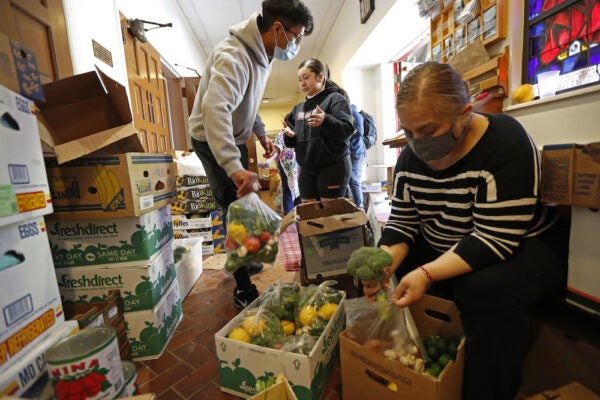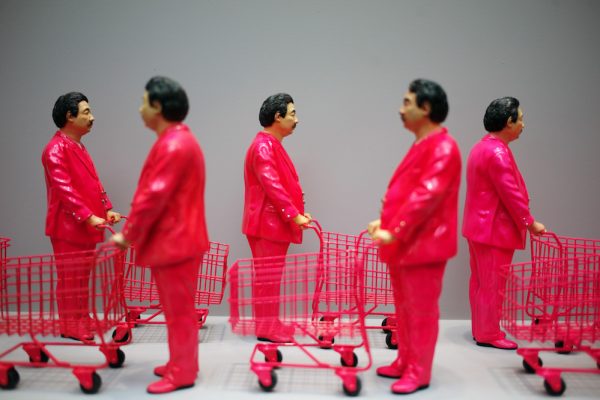
“We have learned by ourselves, from others around us, and from sheer necessity, that we can … make a deliberate choice,” writes Virginia L. Bartlett. Courtesy of Eric Fischer/flickr.
I.
On the walls of Cedars-Sinai Medical Center, where I work, there is a print by the artist Raymond Pettibon. It shows a swath of blue paint above the words, “Yes, but alas, the blue sky has been repainted. By restoration, there is no telling how much you have lost.”
I usually visit Pettibon’s work on my way back from teaching rounds with the medical teams in the Intensive Care Unit. Alone after raw encounters with broken and ailing bodies and disrupted lives, I often seek out the reminder: restoration may not be enough.
Pettibon’s work asks us not to accept the illusion of restoration to what was before. It calls on us not to lose lessons and opportunities that emerge through adversity. It reminds us that sometimes, in the seemingly unimaginable, we find an invitation to imagine anyway: to see our way forward, further than where our fates have brought us, beyond where we started.
I have visited Pettibon’s “Yes, but alas” hanging in its quiet hallway behind the chapel at least once a week since the pandemic began.
As I stand there, taking a minute to check myself, a thought revisits me: Maybe none of us, with our already strained bandwidth, can take on all the moral challenges raised by this pandemic. But perhaps we can take on some, or even one, of the concerns that we may not have recognized before.
Perhaps we can make space and time to accept and offer invitations to listen, whether in clinical or community contexts. We can think differently about our collective challenges, imagining beyond what we once thought we knew—not restoration, but regeneration.
II.
As a clinical ethics consultant, educator, and public scholar, I engage questions about complex moral experiences in healthcare settings. I work with patients, families, nurses, physicians, social workers, chaplains, lawyers, and administrators. When someone calls for a clinical ethics consultation, it is because they seek support in a crisis: there’s confusion or miscommunication to think through… an impasse to overcome… the aftermath of a disease or accident with which they must now learn to live. My practice is to make space and time for those involved to communicate and connect with each other, confronting what James Agee called “the cruel radiance of what is.” Together, we walk through their concerns.
Navigating the unwelcome uncertainties of giving and receiving care means brushing against structural factors that shape interpersonal encounters. Communal and institutional politics; local, state, and federal law; theoretical frameworks; and public health policies intersect actual people’s lives. In such moments of crisis, suddenly we see our taken-for-granted ways of being in the world, and often-unspoken values, come into sharp focus. Especially when they collide with those carried by other people.
I’ve learned that those collisions can be hard. In moments of uncertainty—medical and moral—it can be daunting to see beyond oneself, to imagine another’s experience and hear their perspectives. We have to choose deliberate understanding: what social psychologist Pierre Bourdieu describes as a focused attention to different people that lets us see them as whole persons, not just caricatures or types. Ethics consultants strive to make space in those morally and emotionally charged moments for people to do that: to pause, to see and hear each other and find ways through, as whole persons, together.
III.
COVID-19 hasn’t changed the character of clinical ethics work, but I have begun to see new parallels between conversations taking place in the hospital and conversations unfolding in our local and national communities. On patient wards and in neighborhoods, moral encounters emerging from the pandemic remind us of commitments and connections we often overlook in our everyday, pre-pandemic hustle and bustle. More clearly than ever, the “we” encountering moral experiences includes not only family and neighbors, but also unknown strangers, near and far, on whom we are dependent and from whom we can learn.
The pandemic has laid bare and exposed our interdependence in ways that deeply challenge the American mythos of rugged individualism. It has exposed the raw injustice we all suffer as what philosopher Herbert Spiegelberg calls “fellows in the fate of existence”: those persistent and deeply ingrained inequities that are taken for granted simply because some are born to more resources, safety, health, and community than others.
All anyone has to do, in any of our communities, is look around the neighborhood to find someone experiencing a very different pandemic than themselves. If some aspect of This Pandemic Life is difficult for me, that gives me an opportunity to consider how it might be for a neighbor, in different circumstances.
Making connections to these different experiences—even at a near distance within our neighborhoods, religious congregations, school communities, and “work families”—can help bring to light individual needs and challenges we may not have seen before. Those connections can introduce us to resources, coping mechanisms, and networks of support we haven’t yet considered. We haven’t yet had to, until now.
Inviting these connections is a kind of moral engagement: a listening and telling, an affiliation, as the philosopher and ethicist Richard M. Zaner has written. I help make space for these conversations in my clinical ethics work. They can be an avenue for understanding within and beyond our communities, even—or especially—in a global pandemic.
This kind of deliberate moral engagement feels strange for many of us—especially mid-pandemic, when everyday challenges make it seem flatly impossible to focus on how others feel. And yet, even in the collective upheaval, engaging in this way offers real possibilities as we look towards our post-pandemic lives.
Can we open to real curiosity, seeing near and far neighbors as they are, rather than as we have imagined? Can others’ perspectives help us see ourselves, our worlds, in new ways, rather than as we have imagined, or hold in idealized memory? Can we recognize that restoration and return to the pre-pandemic world isn’t possible, or even truly desirable?
If we are able to “see with new eyes,” as Marcel Proust invites us, perhaps we can connect our individual, interpersonal experiences and needs to our communal, collective challenges and actions.
IV.
This comes across vividly when we consider the COVID-19 vaccine rollout. Vaccines are closely connected to hopes of returning to normal, to what we have always known and done. Yet in the difficult processes of allocation, distribution, and acceptance, we can see why a return to before is not possible—why restoration cannot be enough.
We should not continue, or consider returning to, a society where unequal access to vaccines takes egregious health disparities and widens them to the point where they are obscene. We should take a hard look at efforts of the well-resourced and privileged to move ahead in vaccine allocation lines. We should direct resources to communities struggling with diseases of poverty and limited access to primary care. We should learn from evidence of generational trauma that impacts community health and a healthcare system that systematically disenfranchises and damages people of color. We should engage with concerns around vaccine hesitance. We should alleviate the burdens on tech-limited Americans (rural and urban, older and poorer) that have made it so difficult for them to navigate online sign-up systems. We should start paying attention to distribution difficulties, material logistics, and systemic inefficiencies that few have had to know or worry about before.
Even as thumbnail sketches, our current vaccine challenges highlight pre-existing conditions that we can no longer ignore.
V.
One year into this overwhelming pandemic, I recognize that accepting responsibility for seeing with others and thinking differently feels heavy. But pandemic experiences also create possibilities for new ways forward. We have had to practice in own lives: seeing anew the way things were, revamping our activities and routines, and making things work in the new normal. We have adapted again and again, even as our surge capacity has been depleted and we’ve despaired that we can’t go on.
We go on (we hope).
Instead of following breadcrumbs of our deep yearning for pre-pandemic life and how things used to be, we continue into the unknown. We have learned by ourselves, from others around us, and from sheer necessity that we can learn to see differently, that we can make a deliberate choice to listen and tell, to understand, to go forward. Not back to before.
In clinical ethics encounters and community moral engagements, we can learn from each other in this unavoidable pause. We can carry on, together, into recuperation, rejuvenation, renovation, regeneration.
After all, as Pettibon reminds me every time I take a moment to stand in front of his beautiful, provocative print: We’re not going back. Too much has been learned—often hard-gained. Too much work lays ahead, for individuals and communities. Too many beloved people have been lost to be forgotten.
My hope is that none of us will paint over these months, grabbing at the blue sky we think we remember.








Send A Letter To the Editors